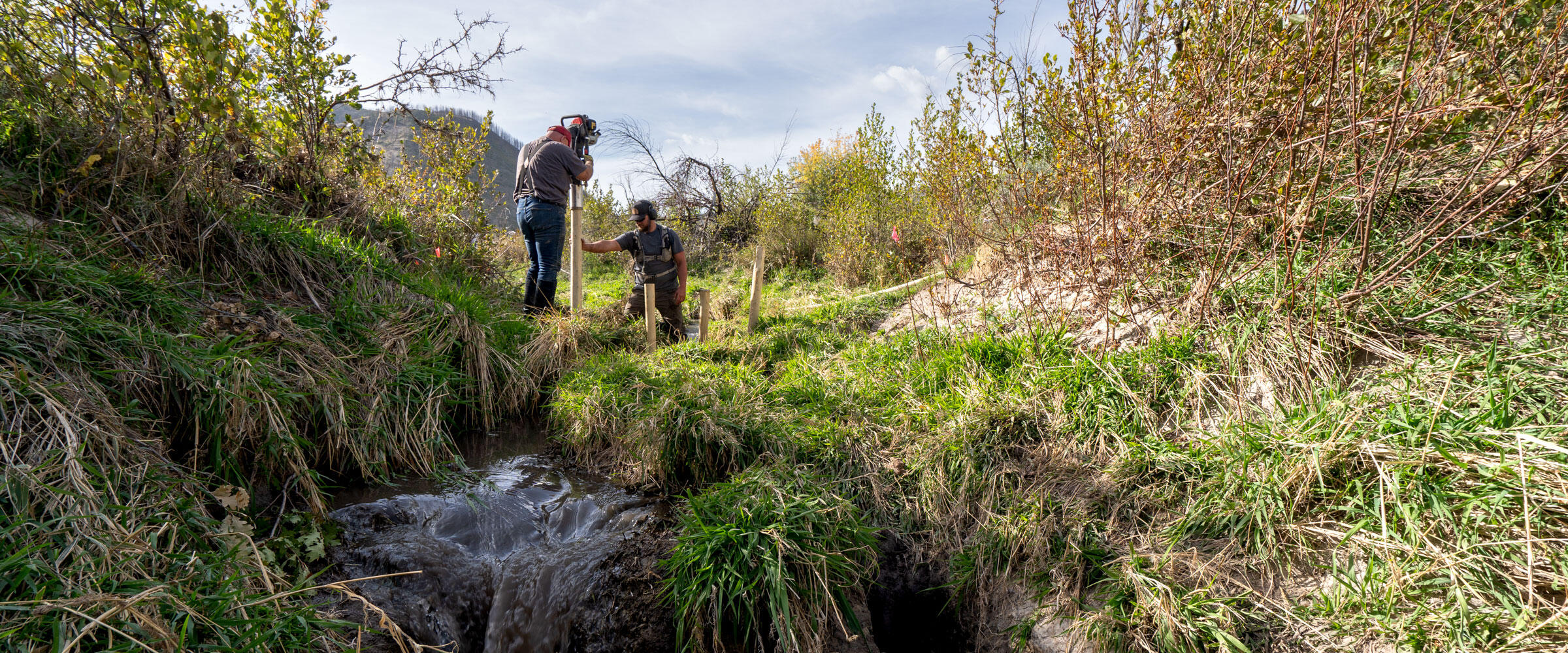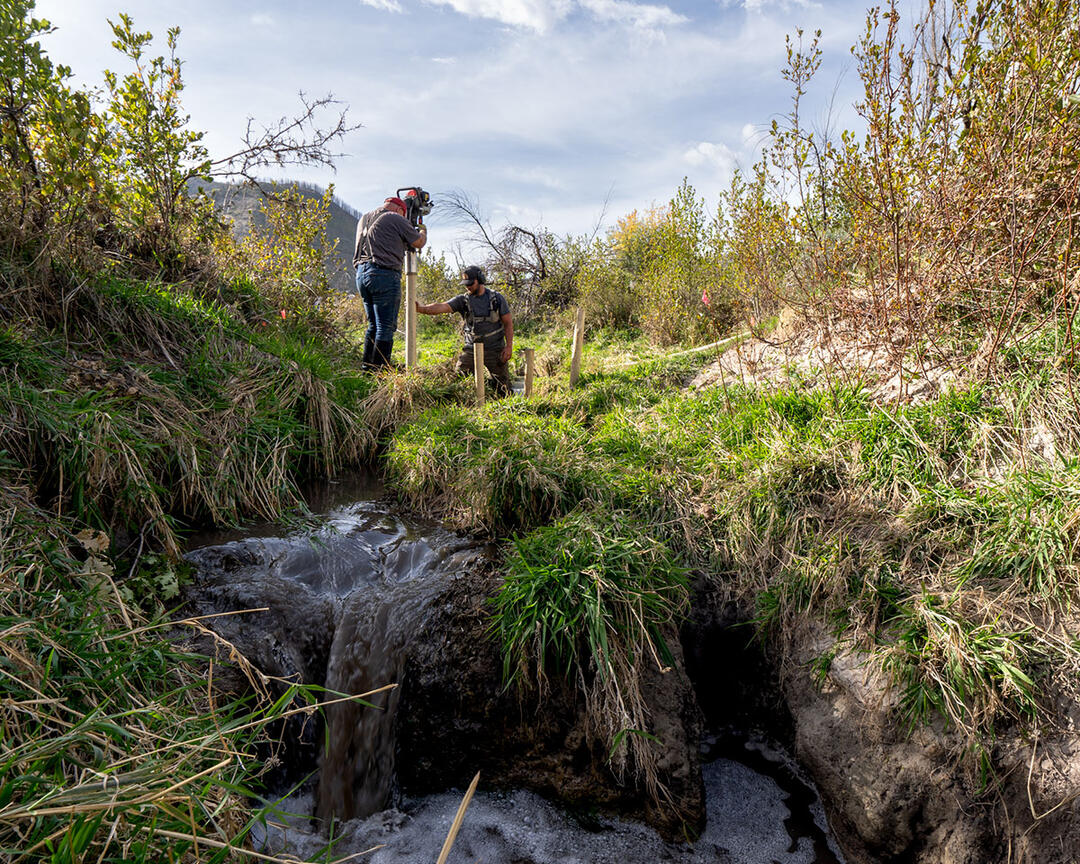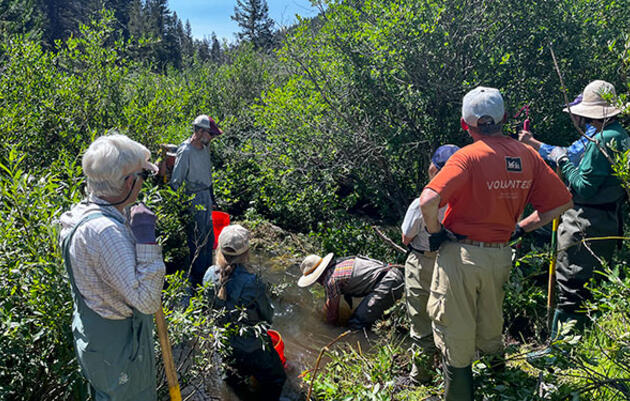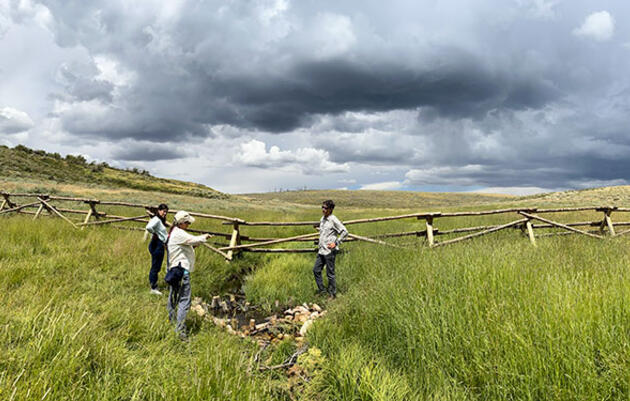In the heart of western Colorado, Dry Fork Creek—a waterway impacted by wildfire—is undergoing an inspiring transformation. What began as hardship is now a hopeful story of bringing restoration to a river-wetland corridor for birds, wildlife, and ranching.
Fed by rain and snowmelt from the Roan Plateau, Dry Fork Creek flows through a valley on the High Lonesome Ranch (HLR) into Roan Creek and ultimately reaches the Colorado River near DeBeque, CO. This small valley influences the Colorado River's health. After the 2020 Pine Gulch Fire burned 139,000 acres, communities watched closely, hoping for gentle precipitation with slow runoff rather than debris-flow-laden storm events, but the latter is what has happened year after year.
Audubon has partnered with HLR to improve the ecological condition of upper Dry Fork Creek, addressing riparian, water quality, and erosion issues. This initial restoration phase brings together Audubon’s Western Rivers staff, an attorney, engineers, a stream restoration consultant, and dedicated funding partners. Together, we’re crafting solutions that will revitalize upper Dry Fork Creek’s river-wetland corridor over the coming years. We look forward to sharing this evolving story through 2026 as the project progresses.
A Shared Vision for Conservation
Spanning over 300 square miles, HLR represents one of the few large, intact landscapes where conservation efforts can make a far-reaching impact. Since joining Audubon Conservation Ranching in 2021 and Audubon Rockies’ Western Rivers Initiative’s Dry Fork Creek Restoration Project in 2022, HLR has provided a unique opportunity to bolster habitat for numerous Colorado bird species. Together, Audubon and HLR work to protect birds and the habitats they rely on for the future.

The vision at the HLR extends beyond sustainability—HLR is committed to demonstrating responsible stewardship that balances economic vitality with the stewardship of public and private lands. This model supports large-scale conservation, with an emphasis on keeping Western landscapes intact and healthy.
However, this balance has not come easily. The Dry Fork Creek corridor, wholly situated on HLR property, endured decades of practices like intensive riparian grazing and in-channel pond construction under previous ownerships. These activities contributed to substantially reduced riparian vegetation and degraded river function.

Today, HLR’s mission is to rejuvenate these habitats and enhance biodiversity and ecological health while protecting vital open spaces and preserving Colorado’s ranching heritage. The objective is to transform impacted lands into resilient habitats that support livestock, wildlife, and bird populations alike.
Working Lands, Water, and Fire
During one of the driest and hottest years in Colorado, the Pine Gulch Fire in 2020 heavily impacted about one-third of the lands used by HLR, and some of the most productive valley bottoms were burned or buried by debris flows, including sections of the North Dry Fork Creek corridor. Beginning in 2021, the Dry Fork Creek corridor experienced significant landscape change repeatedly driven by post-fire flooding and debris flows. Recent floods since 2022—including a historic flood event in August 2024—have delivered massive amounts of shale and rock to the valley bottom, dramatically filling ranch ponds, covering pastures in 2-4 feet of shale, and altering stream channels and riparian-wetland habitat.

Opportunity in the “Devastation”
The aftermath of the wildfire revealed unexpected opportunities for revitalization. In 2022, Audubon’s stream restoration consultant conducted a detailed five-mile ecological assessment of Dry Fork Creek, showing both the challenges and the recovery potential for the river valley bottom. Despite the extensive post-fire impacts, the assessment indicated strong opportunities for ecological restoration and in some cases accelerated recovery potential of incised stream reaches using the debris flows. Key assessment findings included:
- Resilient Beaver Population: A few beavers were still active in the valley, indicating with vegetation recovery the potential for natural ecosystem engineering.
- Disconnected and Incised Stream Reaches: Certain stream segments were deeply incised, draining nearby meadows and lowering groundwater tables.
- Restrictive Culverts: Undersized culverts were impeding stream connectivity, causing erosion and forming scour plunge pools.
- Sediment-Filled Ponds: Sediment from debris flows transformed ponds in the Dry Fork Valley into shallow, braided stream systems accelerating stream restoration potential.
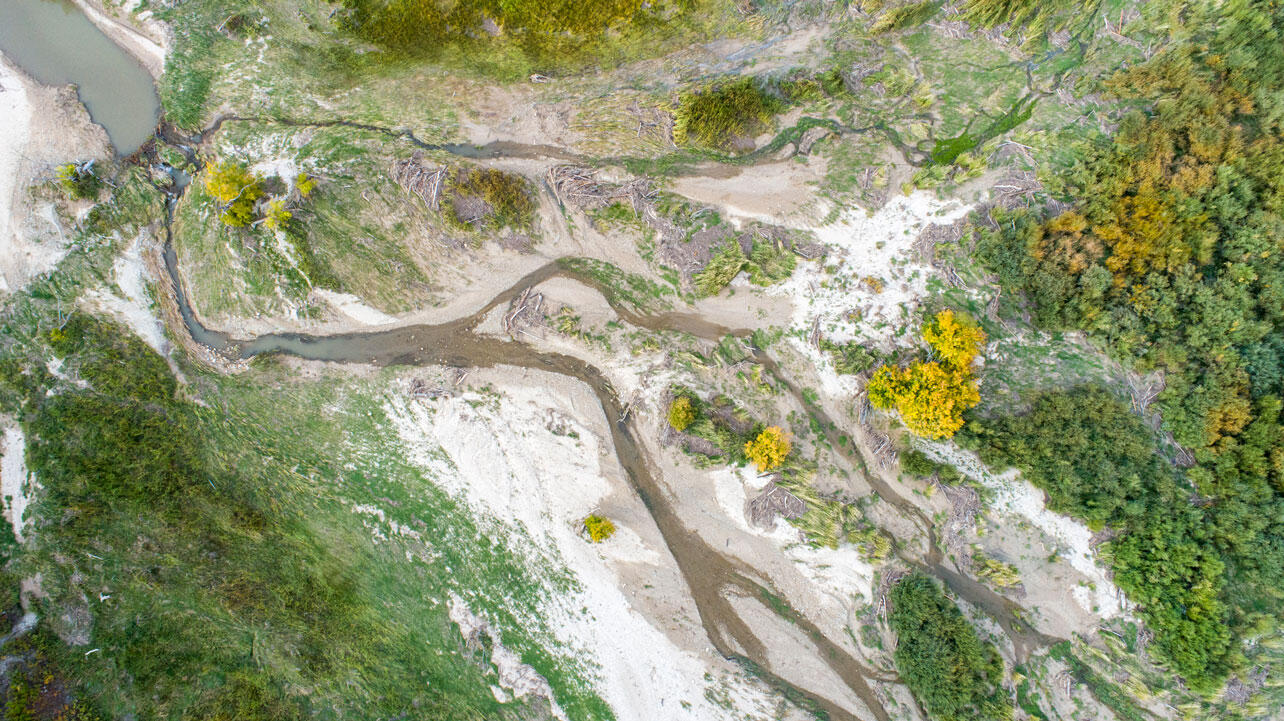
Amid the “devastation,” sections of the river corridor remained functional, and debris flows contributed massive amounts of sediment that helped reconnect some areas of Dry Fork floodplain that were previously deeply incised. Seeing this, the project team identified a unique opportunity: by removing undersized culverts and using restoration structures to help re-establish floodplain connectivity, they could enhance riverscape function and create habitats for birds, wildlife, and riparian wetland vegetation. As restoration efforts progress, expanding beaver habitats are expected to play a vital role, eventually allowing natural processes to take over.

Additionally, HLR is situated within the Middle Colorado River Watershed and any restoration activities on the ranch to improve river corridor function would be additive to the Middle Colorado River Integrated Water Management Plan goal “to evaluate, protect and enhance the health of the middle Colorado River watershed through the cooperative effort of watershed stakeholders.”
The Project “Labor Ecosystem” - Partnership in Action
Since the Dry Fork Creek Restoration Project is at an ambitious scale, stretching just under two miles, Audubon convened an interdisciplinary team composed of an attorney, an engineering firm, and a stream restoration consultant to support due diligence for the private landowner and durable project success. A strong project requires putting together the right team of people with the right skills in the right place.
For the Dry Fork Creek Restoration Project, the team includes
- Project Developer and Manager (Audubon staff): Oversees project planning, coordination, and implementation.
- Legal Support: Provides guidance on state water law, downstream water user rights, and compliance with regulations.
- Restoration Project Designer and Consultant: Contributes expertise on ecological restoration design and techniques applied.
- State/Federal Permit Specialists: Helps navigate the federal and state regulatory landscape.
- Laborers and Installers: Crew to construct key elements of the project, including harvesting local materials like logs and rocks, moving materials, and installing posts and other structures.
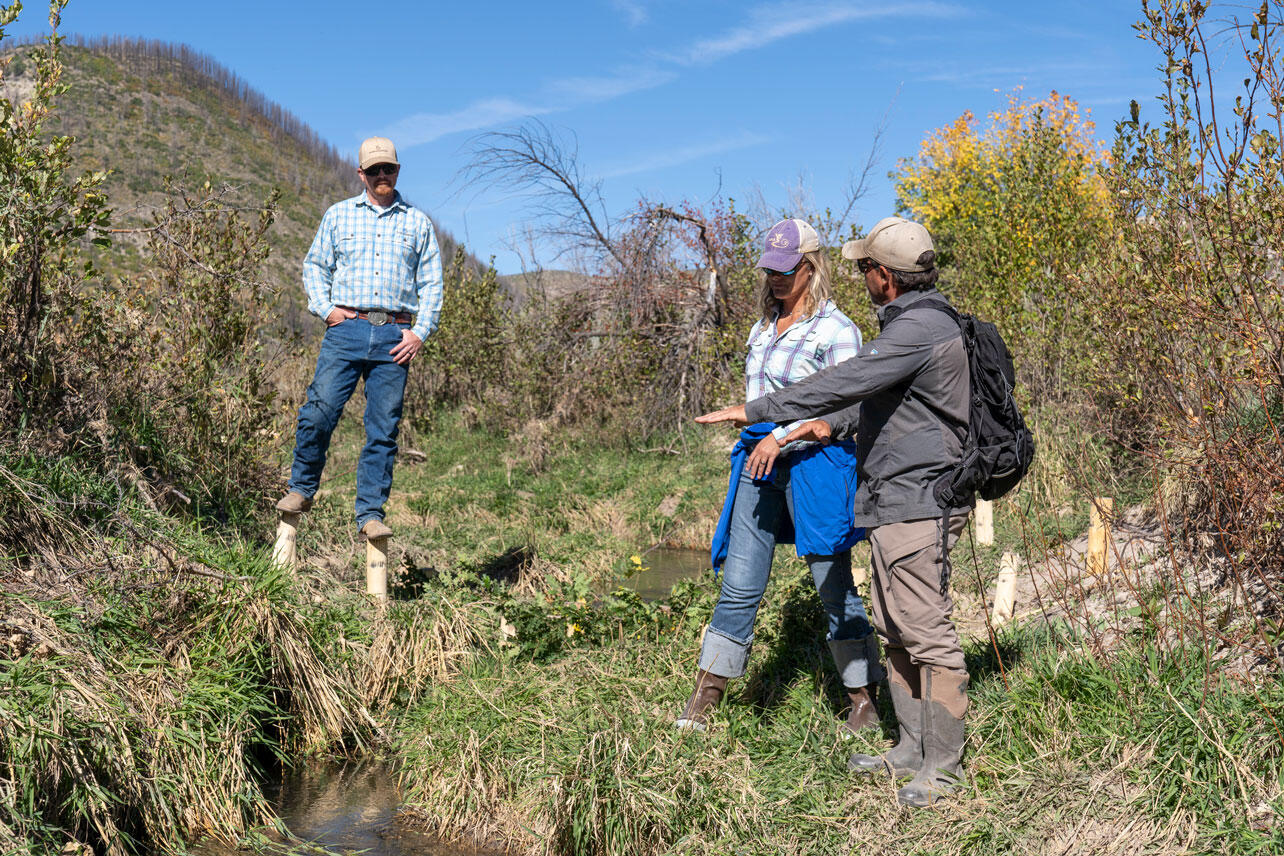
In addition to using LTPBR methods, for the Dry Fork Creek Restoration Project Audubon also has engineering and construction support for replacing a restrictive culvert and constructing a low-ford water crossing (a high-tech PBR approach) that will facilitate floodplain reconnection to be completed by the end of 2024.
The strength of this project lies in the synergy among team members. For example, Audubon’s staff, the attorney, engineering firm, and restoration consultant collaborated on the scope, design, and permitting for critical project elements. Together, the team navigated federal U.S. Army Corps of Engineers permits such as the NW-14 permit for engineered crossings and the NW-27 permit for in-channel habitat restoration. The team also addressed the application of SB23-270 criteria to the proposed in-channel restoration work. These collaborative efforts ensure that project plans align with the functionality of the river corridor, legal, and operational needs of the surrounding ranch.
By uniting a skilled and collaborative team, Audubon aims to limit risk to the landowner and achieve optimal river corridor restoration and ranch operational outcomes, setting a standard for future projects.
Many Tools in the Stream Restoration Toolbox
Restoring Colorado's diverse stream systems requires a tailored approach. Each river and stream has unique needs and no single tool or technique fits all. Instead, stream restoration employs a variety of active and passive recovery methods designed to address environmental stressors, reduce degradation, and support the function and natural dynamics of river ecosystems.
Stream restoration has evolved over the past 15 years to include an approach called Process-Based Restoration (PBR) that covers a spectrum of restoration methods that aim to target the root causes of ecosystem stressors and restore a river’s natural processes (e.g. hydrology, sediment transport, nutrient cycling) so that the riverscape can begin to self-heal. PBR focuses on letting natural processes heal the riverscape, rather than relying solely on human intervention. This approach uses both high-tech (like engineering solutions) and low-tech methods (like structures made of natural materials built by hand) to help restore the creek’s natural hydrology and improve wildlife habitat.

The Dry Fork Creek Restoration Project uses Low-Tech Process-Based Restoration (LTPBR), a subset of PBR, which relies on simple, hand-built structures that mimic the natural wood accumulations or beaver dams found in healthy stream systems. By placing these structures strategically, the project “kick-starts” the natural ecological, geomorphic, and hydrologic processes that can accelerate recovery in degraded stream sections. This low-tech approach is adaptable and particularly well-suited for Dry Fork Creek. The project also is employing the use of high-tech PBR by removing an undersized culvert on a ranch road that is constricting and channeling the force of run-off, which has caused stream incision. The culvert will be replaced with a low-ford crossing that will allow for floodplain reconnection.
Many studies showing the effectiveness of PBR present an enormously important opportunity for Colorado and the Intermountain-West to restore its degraded river ecosystems.
People and Beavers Working on the Creek - Phase 1, September 2024
With bird and wildlife conservation and operational ranching as key goals, this project is an example of how collaborative, science-driven approaches -can restore a river corridor. The restoration efforts at Dry Fork Creek are focused on enhancing the natural processes of the river system to benefit a wide range of ecosystem functions and species. Specific goals of the project include
- Reconnecting Hydrology and Increasing Floodplain Connectivity: By restoring the natural hydrology between the creek and its floodplain, the project aims to support a healthier water system.
- Supporting Native Beaver Activity: Encouraging beaver populations, which naturally enhance stream health and resilience.
- Improving Water Quality: By capturing excessive sediment and treating erosional headcuts, the project aims to manage post-fire debris flows and improve the overall water quality in Dry Fork Creek.
Audubon acknowledges the rare privilege it is to work on SB23-270’s development, passage, and now implementation of a project under the new law. The project fits within criteria (F) for post-fire emergency restoration within the natural stream system. Based upon written communication with the Division of Water (DWR) Resources Division 5 Engineer about the project, DWR agreed with Audubon’s analysis that the project fits within criteria (F).
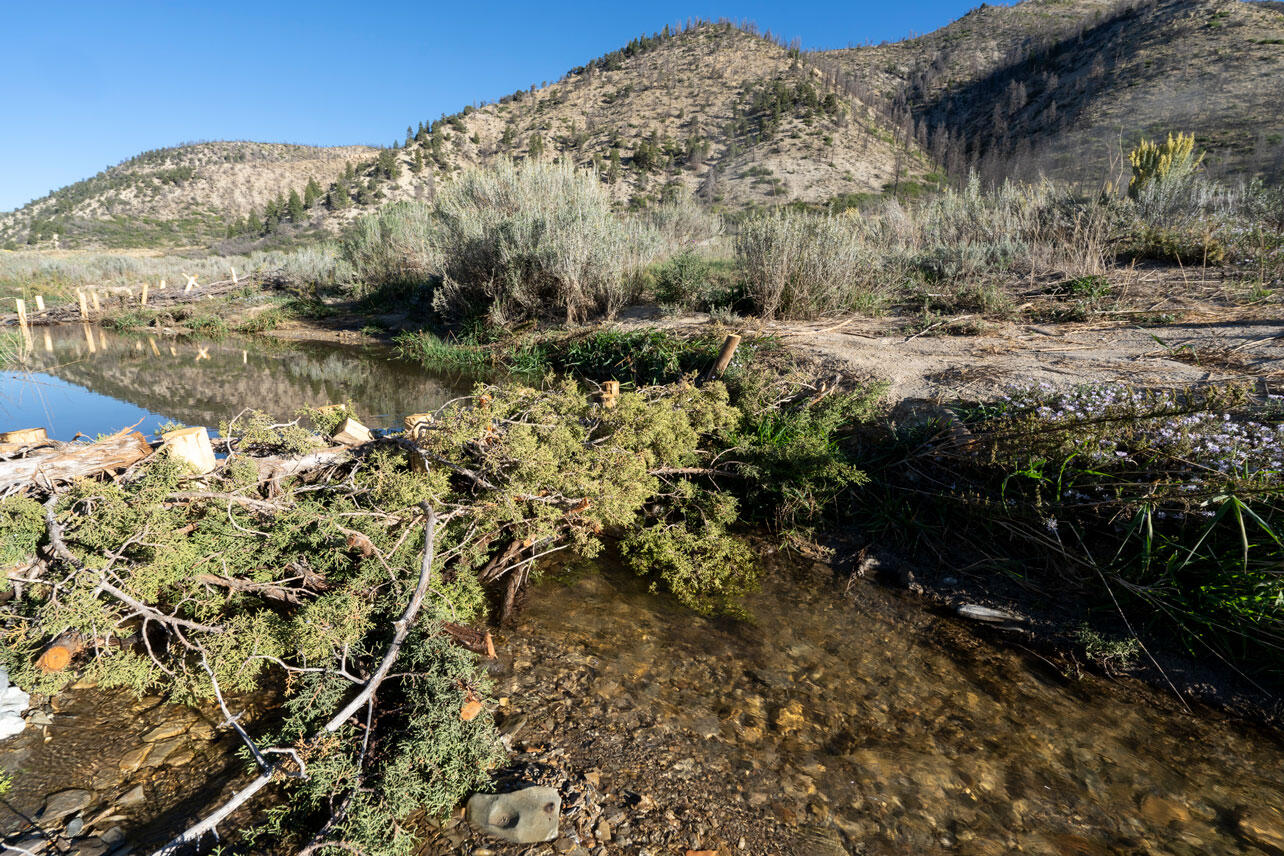
In September 2024, as part of the first phase of a two-year implementation and adaptive management cycle, 82 low-tech structures were installed across Dry Fork Creek. These structures, which utilize more than a dozen design variations, are crafted to support the unique needs of the creek and surrounding landscape. Through these installations, the project aims to restore channel processes, increase groundwater storage, and improve riparian vegetation for birds, wildlife, and livestock.
Bringing the Pieces Together
Audubon appreciates the many people and organizations recognizing the potential of broad benefits in restoring rivers across Colorado and the West. By bringing many pieces together in this partnership-driven conservation effort, approximately $775,000 have been invested in improving Dry Fork Creek and restoring its functionality for the entire community of users: birds, wildlife, livestock, and people.
Audubon thanks HLR for their partnership and commitment to land and water stewardship, as well as the Colorado Water Conservation Board, Colorado River Sustainability Campaign, RESTORE Colorado, National Wildlife Federation, and the Mule Deer Foundation for investing in this large-scale project.
We look forward to sharing more about the Dry Fork Creek project story of improved habitat and ecological condition through the lens of birds. Through continued partnership, community support, and innovative restoration, we aim to revive Dry Fork Creek and Colorado’s rivers for generations.

